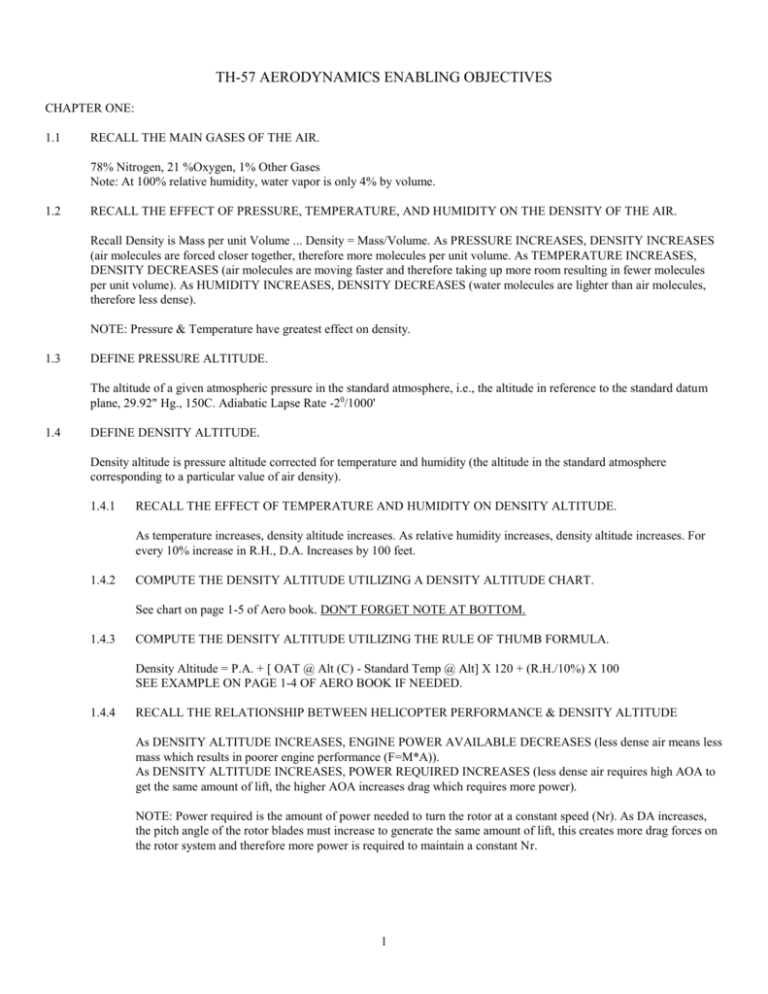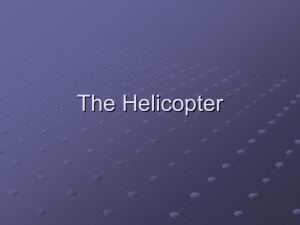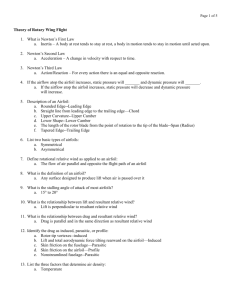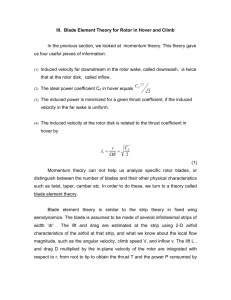Aero enabling objectives
advertisement

TH-57 AERODYNAMICS ENABLING OBJECTIVES CHAPTER ONE: 1.1 RECALL THE MAIN GASES OF THE AIR. 78% Nitrogen, 21 %Oxygen, 1% Other Gases Note: At 100% relative humidity, water vapor is only 4% by volume. 1.2 RECALL THE EFFECT OF PRESSURE, TEMPERATURE, AND HUMIDITY ON THE DENSITY OF THE AIR. Recall Density is Mass per unit Volume ... Density = Mass/Volume. As PRESSURE INCREASES, DENSITY INCREASES (air molecules are forced closer together, therefore more molecules per unit volume. As TEMPERATURE INCREASES, DENSITY DECREASES (air molecules are moving faster and therefore taking up more room resulting in fewer molecules per unit volume). As HUMIDITY INCREASES, DENSITY DECREASES (water molecules are lighter than air molecules, therefore less dense). NOTE: Pressure & Temperature have greatest effect on density. 1.3 DEFINE PRESSURE ALTITUDE. The altitude of a given atmospheric pressure in the standard atmosphere, i.e., the altitude in reference to the standard datum plane, 29.92" Hg., 150C. Adiabatic Lapse Rate -20/1000' 1.4 DEFINE DENSITY ALTITUDE. Density altitude is pressure altitude corrected for temperature and humidity (the altitude in the standard atmosphere corresponding to a particular value of air density). 1.4.1 RECALL THE EFFECT OF TEMPERATURE AND HUMIDITY ON DENSITY ALTITUDE. As temperature increases, density altitude increases. As relative humidity increases, density altitude increases. For every 10% increase in R.H., D.A. Increases by 100 feet. 1.4.2 COMPUTE THE DENSITY ALTITUDE UTILIZING A DENSITY ALTITUDE CHART. See chart on page 1-5 of Aero book. DON'T FORGET NOTE AT BOTTOM. 1.4.3 COMPUTE THE DENSITY ALTITUDE UTILIZING THE RULE OF THUMB FORMULA. Density Altitude = P.A. + [ OAT @ Alt (C) - Standard Temp @ Alt] X 120 + (R.H./10%) X 100 SEE EXAMPLE ON PAGE 1-4 OF AERO BOOK IF NEEDED. 1.4.4 RECALL THE RELATIONSHIP BETWEEN HELICOPTER PERFORMANCE & DENSITY ALTITUDE As DENSITY ALTITUDE INCREASES, ENGINE POWER AVAILABLE DECREASES (less dense air means less mass which results in poorer engine performance (F=M*A)). As DENSITY ALTITUDE INCREASES, POWER REQUIRED INCREASES (less dense air requires high AOA to get the same amount of lift, the higher AOA increases drag which requires more power). NOTE: Power required is the amount of power needed to turn the rotor at a constant speed (Nr). As DA increases, the pitch angle of the rotor blades must increase to generate the same amount of lift, this creates more drag forces on the rotor system and therefore more power is required to maintain a constant Nr. 1 CHAPTER TWO 2.1 DRAW A BLADE ELEMENT DIAGRAM. 2. 1.1 DEFINE: AIRFOIL, CHORDLINE, TIP-PATH PLANE, AERODYNAMIC CENTER, ROTOR DISC, PITCH ANGLE, LINEAR FLOW, INDUCED FLOW, ANGLE-OF-ATTACK (AOA), LIFT, INDUCED DRAG, PROFILE DRAG, THRUST, IN-PLANE DRAG. AIRFOIL: A structure designed to produce lift as it moves through the air CHORD: The distance between the leading and trailing edges along the chordline CHORDLINE: A straight line intersecting the leading and trailing edges of an airfoil TIP-PATH PLANE: The path described by the tips of the Main Rotor Blades as they rotate AERODYNAMIC CENTER: Point along the chordline where all changes in lift are considered to take place CENTER OF PRESSURE: Point along chordline at which all aerodynamic forces (distributed lift, upper and lower surface) are acting ROTOR DISC: Area of the circle inscribed in the tip-path-plane PITCH ANGLE: Angle between the CHORD LINE and the TIP-PATH-PLANE LINEAR FLOW:- HORIZONTAL flow of air, opposite the direction of the airfoil ROTATIONAL FLOW: Linear flow for rotating airfoils (rotor blade) INDUCED FLOW: DOWNWARD (VERTICAL) flow of air through the rotor (i.e., Rotor-Wash) ANGLE-OF-ATTACK (AOA): Angle between the RELATIVE WIND and the CHORD LINE LIFT: The component of the total aerodynamic force (thrust) which is perpendicular to the relative wind INDUCED DRAG: The horizontal component of lift (parallel to the tip-path-plane) which tilts the lift vector aft; caused by induced flow and trailing vortices PROFILE DRAG: Result of air friction acting on the blade element. (parallel to the relative wind) NOTE: In a hover profile drag accounts for 25% of the total power, 75% of the power is induced power 2 THRUST: Rotor thrust is the total aerodynamic force produced in the rotor system used to overcome the weight of the helo. IN-PLANE DRAG: The summation of all decelerating forces in the plane of rotation (Induced Drag + Horizontal Component of Profile Drag) 2.1.2 STATE THE RELATIONSHIPS BETWEEN INDUCED FLOW, LINEAR FLOW, AND RELATIVE WIND; BETWEEN RELATIVE WIND AND ANGLE-OF-ATTACK; BETWEEN PITCH ANGLE AND ANGLE-OF-ATTACK. RELATIVE WIND is the vectorial resultant of LINEAR FLOW + INDUCED FLOW. Increasing induced flow shifts the relative wind toward the chord line (more vertical), thereby reducing AOA. Increasing the linear flow will shift the relative wind away from the chord line (more toward the horizontal) and thereby increase the AOA. Pitch angle directly affects AOA. (As pitch angle increases, AOA increases, which increases LIFT). In Summary: As Pitch Angle Increases - AOA Increases As Linear Flow Increases - AOA Increases As Induced Flow Increases - AOA Decreases LIKEWISE: As Pitch Angle Decreases - AOA Decreases As Linear Flow Decreases - AOA Decreases As Induced Flow Decreases - AOA Increases 2.2 DIFFERENTIATE AND CHARACTERIZE THE SYMMETRICAL AND NONSYMMETRICAL AIRFOILS. SYMMETRICAL: Same shape & size above & below the chord line 14ONSYMMETRICAL: Different shape & size above & below the chord line. When LIFT is created on a nonsymmetrical airfoil a TWISTING moment is created due to the unequal forces above & below the airfoil. NOTE: TH-57 uses a "Droop-snoot" airfoil (nonsymmetrical) which provides good characteristics at high AOA and produces very little twisting moments. 2.3 DEFINE GEOMETRIC TWIST AND STATE WHY IT IS USED IN HELICOPTER DESIGN. Geometric twist is the intentional twisting of the rotor blade to help more equally distribute the Aerodynamic Force (i.e., Lift) along the blade. It is needed because more lift is present at the tip than the root because there is more linear flow at the tip because the tip is traveling much faster than the root. The pitch of the blade is reduced from the root outward to the tips. The TH-57 has 5 degrees of geometric twist. 2.4 DEFINE FLAPPING: Vertical blade movement. Allows the rotor disk to be tilted and compensates for dissymmetry of lift 2.5 DEFINE GEOMETRIC IMBALANCE. 2.5.1 STATE HOW GEOMETRIC IMBALANCE AFFECTS HORIZONTAL BLADE MOVEMENT (LEAD/LAG) When the rotor disc is tilted, the radius of the center-of-mass for the rotor blades is changed. In order to maintain a constant linear velocity, the rotational velocity must change whenever the radius changes. As the disc is tilted, the radius of the down blade is increased and therefore the rotational velocity for that blade must decrease (i.e., LAG). The radius for the up-going blade is decreased and therefore its rotational velocity must increase (LEAD). 3 2.6 DIFFERENTIATE AND CLASSIFY THE THREE TYPES OF ROTOR HEADS USED TODAY. 2.6.1 STATE THE METHOD BY WHICH FLAPPING IS ACCOMPLISHED IN EACH SYSTEM. RIGID: The rotor hub bends to allow flapping, lead/lag, and pitch control. (Rotor head made of composite material) SEMI-RIGID: Uses horizontal hinge pin in center of rotor head to allow flapping. Uses underslinging to compensate for geometric imbalance instead of allowing lead/lag. FULLY ARTICULATED: Uses vertical hinge pins for independent movement in the horizontal plane (Lead/Lag, Hunt/Drag) and horizontal hinge pins for independent movement in the vertical plane (flapping). No movement is permitted between the MRH and the mechanical axis. 2.6.2 STATE THE METHOD BY WHICH GEOMETRIC IMBALANCE IS COMPENSATED FOR OR ELIMINATED IN EACH SYSTEM. Geometric imbalance can be overcome in two ways. 1. by allowing the individual blades to move independently in the horizontal plane the blades can LEAD and LAG as necessary when the rotor disc is tilted to compensate for the changing radii of the blades. This is accomplished by using a Vertical Hinge Pin for the rotor blades in a Fully Articulated Rotor Head and by allowing bending of the Rigid rotor head. 2. Semi-rigid rotor heads use underslinging to compensate for geometric imbalance. By underslinging the rotor head, as the rotor head tilts, the radii of both blades will increase or decrease equally and therefore no lead/lag is necessary. CHAPTER THREE 3.1 DRAW AND LABEL A POWER REQUIRED/POWER AVAILABLE CHART AND A FUEL FLOW VERSUS AIRSPEED CHART. See figure 3-2, 3-3 and 3-4 in Aero book. Charts are NOT TH-57 charts. 3. 1.1 IDENTIFY MAXIMUM ENDURANCE AIRSPEED. 50 Knots for the TH-57 (lowest point on power required curve) NOTE: IF PARTIAL ENGINE POWER IS LOST (UNDERSPEED), IT IS BEST TO FLY MAX. ENDURANCE AIRSPEED. 3.1.2 IDENTIFY MAXIMUM RATE OF CLIMB AIRSPEED. 50 Knots (Lowest point on power required curve, maximum power available) 3.1.3 IDENTIFY BEST RANGE AIRSPEED AND STATE THE EFFECTS OF WIND COMPONENTS ON BEST RANGE AIRSPEED. Best range airspeed is the point where a line drawn from the origin is tangent to the power required curve. A tailwind will shift the origin left & therefore reduce best range airspeed, but increase distance. A headwind will shift the origin right and therefore increase best range airspeed, but decrease distance. 72 KIAS for the TH-57. 3.2 DEFINE TORQUE EFFECT. Due to the momentum of the advancing blade on the right, there is an equal & opposite reaction (Torque) which causes the helo to rotate to the RIGHT. 4 3.2.1 STATE THE MEANS BY WHICH WE COUNTERACT TORQUE. By use of a tail rotor which produces a thrust to the right, creating left yaw and thereby counteracting torque. 3.2.2 STATE THE MEANS BY WHICH WE CONTROL THE HELICOPTER ABOUT THE VERTICAL AXIS. A LEFT yaw is accomplished by INCREASING tail rotor thrust and thereby OVERCOMPENSATING for the torque effect. A RIGHT yaw is accomplished by DECREASING tail rotor thrust and thereby UNDERCOMPENSATING for the torque effect. 3.2.3 STATE THE MEANS BY WHICH A MULTI-ROTOR HEADED SYSTEM COUNTERACTS TORQUE. By using an even number of rotor systems rotating in opposite directions. 3.3 STATE THE EFFECT THE TAIL ROTOR WILL HAVE ON POWER AVAILABLE TO THE MAIN ROTOR. The tail rotor uses 5 to 15% of the total power available, therefore leaving 85-95% for the main rotor. 3.4 STATE THE TWO MEANS BY WHICH TAIL-ROTOR LOADING IS REDUCED IN FORWARD FLIGHT. The WEATHER-VANING effect of the fuselage and the horizontal lift created by the VERTICAL STABILIZER. The vertical stabilizer effectiveness increases as airspeed increases; at approximately 95 kts and above, you actually have to add right rudder to maintain heading. 3.5 STATE ONE PROBLEM CREATED BY USE OF A TAIL ROTOR SYSTEM TO COUNTERACT TORQUE. The sideward thrust of the tail rotor causes the helo to drift right. This is called translating tendency. To counteract this right drift you must add a small amount of left cyclic. This causes the helo to take off right skid first and to hover left skid low. REMEMBER: During engine loss in a hover you must take out this correction; otherwise the helo will drift left. 3.6 DEFINE VIRTUAL AXIS, MECHANICAL AXIS, AND CENTER-OF-GRAVITY. MECHANICAL AXIS: The extension of the center line of the rotor mast (the actual axis of rotor head). VIRTUAL AXIS: An axis perpendicular to the plane of rotation. As the rotor tilts the virtual axis tilts and remains perpendicular to the plane of rotation. CENTER-OF-GRAVITY: The balancing point for a body 3.6.1 STATE THE RELATIONSHIP BETWEEN CENTER-OF-GRAVITY, MECHANICAL AXIS, AND THE VIRTUAL AXIS. The center-of-gravity should be in-line with the mechanical axis but realistically cannot always be. When not in line the cyclic must be displaced to compensate for the unbalanced CG condition. During flight, as the virtual axis tilts (to change helo direction) the CG attempts to align with virtual axis. 3.7 LIST THE FORCES ACTING ON THE MAIN ROTOR HEAD. CENTRIFUGAL FORCE (greatest force, proportional to square of Nr), AERODYNAMIC FORCE 3.7.1 DEFINE CENTRIFUGAL FORCE AND AERODYNAMIC FORCE. Centrifugal force is the outward force created by the rotation of the main rotor head. The large centrifugal force is what allows the weight of the helicopter to be supported by the flexible rotor blades. Aerodynamic force is the summation of all forces involved in creating lift. (Lift, Induced Drag, Profile Drag) 5 3.7.2 DEFINE CONING AND THE CONING ANGLE CONING is the upward displacement of the main rotor blades due to the interaction of centrifugal force and aerodynamic force. CONING ANGLE is the angle between the tip-path-plane and the main rotor blades. NOTE: Weight, G-force, and RPM affect coning angle. If Lift (aerodynamic force) is constant and Nr increases, coning angle decreases. If Nr is constant and lift (aerodynamic force) increases, coning angle increases. Low RPM and excessive weight can cause excessive coning which essentially decreases the rotor disc area and therefore reduces lift. 3.8 INTERPRET HOW A VORTEX IS FORMED AND HOW IT AFFECTS THE EFFICIENCY OF THE ROTOR SYSTEM. High pressure air under the airfoil swirls around the blade to fill the low pressure area on top of the blade. The greater the LIFT, the greater the pressure differential, and therefore the greater the main rotor blade vortices. Since this transfer of air decreases the pressure differential between the top and bottom of the rotor blade, it should be obvious that the formation of a Vortex DECREASES the rotor system efficiency. NOTE: These MRB vortices occur at both the Tips of the blades and the Root End of the blades (Hub). 3.9 STATE THE EFFECT MAIN ROTOR VORTICES HAVE IN THE TAIL ROTOR AT LOW AIRSPEEDS. At airspeeds less than 30 kts and with winds from the forward port side of the helo (285 to 315 degrees) the Main Rotor Vortices may be directed onto the tail rotor, which will increase the AOA of the tail rotor which produces the same effect as adding left pedal. Assume you are doing a right pedal turn, when the wind is off your forward port side (285-315 degrees off your nose) the tail rotor will begin to experience the effects of the main rotor vortex. The tail rotor AOA will increase (because the main rotor disk vortices decrease the relative induced flow), and the helo acts as if you are adding left pedal. To compensate for this you add right pedal so you can maintain the same turn rate. The problem arises as the helo continues to turn. When the wind is out of the 285-315 degree range (off the nose) the main rotor vortex will be blown away from the tail rotor and you find yourself with much more right pedal applied than you need and a sudden right yaw acceleration develops. Therefore, you must anticipate this and be ready to apply left pedal during your turn. 3.10 DEFINE GROUND EFFECT BY STATING THE TWO EFFECTS WHICH CAUSE IT. Ground effect is a favorable aerodynamic phenomenon which requires less power when the helicopter is within one rotor diameter of the ground. 1. 2. Most important is the reduction of the velocity of the induced flow because the ground interrupts the air flow under the helo. As the induced flow decreases, induced drag decreases and tilts the lift vector more vertical. Therefore, you can reduce pitch and still generate the same amount of lift. Reduction in rotor TIP vortex formation. 3.10.1 STATE HOW GROUND EFFECT AFFECTS POWER REQUIRED. Ground effect increases rotor efficiency therefore reducing power required. Ground effect begins at approximately one rotor diameter from the earth. It is best over smooth paved surfaces. 3.11 DEFINE GROUND VORTEX AND WHAT CAUSES IT. Ground vortex is when the aircraft overruns its own vortex as it accelerates. As the aircraft flies through the vortex, induced flow is increased, which increases power required. 6 3.12 DEFINE TRANSLATIONAL LIFT BY STATING THE PHENOMENON WHICH CAUSES IT. As the helo moves from a no-wind hover to forward flight, it passes through translational lift, which increases rotor efficiency due to more air flow through the system per unit of time AND because it is now capable of outrunning its vortices which reduces induced flow. Translational lift begins with forward movement, Effective translational lift occurs at 10- 15 knots, Max translational lift occurs at 51 knots. 3.12.1 STATE HOW TRANSLATIONAL LIFT AFFECTS POWER REQUIRED. Since translational lift increases rotor efficiency it REDUCES POWER REQUIRED. 3.13 STATE THE EFFECT OF DISSYMMETRY OF LIFT ON THE HELICOPTER. In forward flight the advancing blade sees an increase in linear flow, which increases the AOA on that blade. The increase in AOA causes lift to increase on the advancing blade. Likewise, the retreating blade sees a decrease in linear flow, a decrease in angle of attack and therefore a decrease in lift. This is obviously undesirable and must be overcome. 3.13.1 STATE THE METHODS BY WHICH DISSYMMETRY OF LIFT IS OVERCOME IN VARIOUS ROTOR SYSTEMS. By allowing vertical movement of the rotor blades (FLAPPING) dissymmetry of lift is overcome. Here's how: In forward flight, the advancing blade sees an increase in linear flow, which increases the AOA on that blade. The increase in AOA causes lift to increase on the advancing blade. Since the rotor system is designed to permit flapping, the blade flaps up as a result of the increase in lift. As the blade flaps up, the upward movement of the blade increases the induced flow seen by that blade. Increasing the induced flow causes the AOA to decrease and therefore decreases lift and the blade comes back down. The opposite occurs on the retreating blade. The retreating blade sees a decrease in linear flow, a decrease in angle of attack and therefore a decrease in lift. The decrease in lift causes the blade to flap down, the downward movement of the blade decreases the induced flow seen by that blade. Decreasing the induced flow causes the AOA to increase and therefore increases lift and the blade comes back up. See OBJECTIVE 2.6.1 for how flapping is permitted in the three types of rotor heads. 3.14 STATE THE EFFECT OF PHASE LAG ON THE CONTROL OF A HELICOPTER. Because of phase lag you must increase Main Rotor Blade AOA 90 degrees prior to the position of desired maximum lift. 3.15 DEFINE BLOWBACK BY STATING THE CAUSE. Dissymmetry of lift and phase lag cause blowback. It is the pitch-up tendency of the aircraft as it accelerates and the pitch-down tendency as the aircraft decelerates. The advancing blade (90 degree position) flaps up due to an increase in lift, an increase in lift at the 90-degree position will manifest itself 90 degrees later (due to phase lag) over the nose. An increase in lift over the nose tends to make the nose pitch up (i.e., blowback). The retreating blade causes a loss of lift over the tail, which also causes the nose to pitch up. 3.15.1 DESCRIBE THE EFFECT BLOWBACK HAS ON HELICOPTER ATTITUDE AND AIRSPEED. As airspeed increases, dissymmetry of lift increases, therefore flapping must increase. As flapping increases, blowback increases, and therefore the nose-up tendency increases, which requires a constant nose-down trimming process. The opposite is true when airspeed decreases. As airspeed decreases, dissymmetry of lift decreases, therefore flapping must decrease. As flapping decreases, blowback decreases and therefore the nose-down tendency increases, which requires a constant nose-up trimming process. 3.16 IDENTIFY FORE-AND-AFT ASSYMMETRY OF LIFT BY STATING TWO EFFECTS WHICH CAUSE IT AND HOW IT AFFECTS HELICOPTER FLIGHT. 7 1. Coning: The combination of forward airspeed and coning results in less induced flow and greater AOA (and greater lift) for the blade over the nose than the blade over the tail. 2. Non-uniform Induced Flow: i.e., Transverse flow. As the helo moves forward through the air the blade over the nose sees clean undisturbed air while the blade over the tail sees the air which is disturbed by rotor vortices. Therefore the lift over the nose is greater than the lift over the tail. This fore & aft assymmetry of lift causes vibrations to be felt at the 90 / 270 degree position (i.e., lateral vibrations) and is greatest at 15 knots. CHAPTER FOUR 4.1 DEFINE AUTOROTATION. Flight without engine power where the air approaching from below the rotor disc keeps the rotor turning at an operational speed (i.e., Self-induced rotation of the rotor system in unpowered flight). May be divided into 3 distinct phases: Entry, Steady State Descent, and Deceleration and touchdown. 4.2 DRAW AND LABEL A BLADE ELEMENT DIAGRAM FOR AUTOROTATION. 4.3 DEFINE PRO-AUTOROTATIVE FORCE. The horizontal component of the lift vector which is tilted forward is the pro-autorotative force. 4.4 DEFINE ANTI-AUTOROTATIVE FORCE. In-plane drag is the sum of all decelerating forces in the plane of rotation and is the anti-autorotative force. 4.5 STATE THE THREE PHASES REQUIRED TO TRANSITION FROM POWERED TO UNPOWERED FLIGHT. The three phases of the ENTRY are: 1. Reduce In-Plane drag to stop RPM decay by lowering the collective. 2. Reversal in induced flow (As helo begins to descend induced flow reverses). 3. Control In-Plane Drag (Nr) by varying the pitch of main rotor blades with the collective. 8 4.6 STATE THE EFFECTS OF A FLARE IN AN AUTOROTATION. The cyclic flare (initiated at 100-75 ft AGL) tilts the rotor disc aft and increases induced flow. This causes the relative wind to shift further down, increases AOA, and the lift vector is increased and tilted more forward (increasing pro-autorotative force) which causes: 1. Sink Rate to Decrease 2. Airspeed to Decrease 3. Rotor RPM to Increase 4.7 STATE THE TWO VARIABLES THAT AFFECT AUTOROTATIVE DESCENT. AIRSPEED & ROTOR RPM Minimum Rate of Descent airspeed is found at the lowest point on the power required vs. airspeed chart (50 kts). Nr other than optimum (94-95%) increases rate of descent. HIGH GROSS WEIGHTS AND HIGH DENSITY ALTITUDES DO NOT AFFECT RATE OF DESCENT. HOWEVER, THEY DO AFFECT: 1. MINIMUM RATE OF DESCENT ROTOR RPM (increases) 2. ENERGY REQUIRED TO ARREST RATE OF DESCENT DURING FLARE 4.8 STATE THE PURPOSE OF THE HEIGHT-VELOCITY DIAGRAM. To identify portions of the flight envelope from which a safe landing can be made in the event of an engine failure. CHAPTER FIVE 5.1 DEFINE RETREATING BLADE STALL BY STATING ITS CAUSE AND THE EFFECTS ON HELICOPTER FLIGHT. 5.1.1 STATE THE SOLUTION TO RETREATING BLADE STALL. As airspeed increases the retreating blade linear flow is reduced. The retreating blade must still produce an amount of lift equal to that of the advancing blade, therefore as lift is list, the blade flaps down, decreasing induced flow. This causes the AOA on the retreating blade to increase. Eventually as airspeed increases, the blade will exceed the critical AOA and will stall. The effect on the helicopter is: 1. 2:1 Vibration level increases 2. Pitch-up of the Nose (Left blade, 270, stalls & due to phase lag loose lift over the tail & nose pitches up) 3. 3. Rolling tendency toward the stalled side (left) During blade stall there will be three factors present: 1. 2. 3. Up collective (increased power for forward A/S - increased blade pitch) Forward Cyclic (For increased forward A/S - causes retreating blade pitch angle to increase) Increased Blade flapping due to high airspeed Factors which increase the potential for blade stall: High Blade Loading (i.e., high Gross Weights / G-loading) Low Rotor RPM Steep or Abrupt Turns Turbulent Air High Density Altitude 9 High Drag Configurations (external sources) Avoid Blade Stall by proper preflight planning. If encountered accomplish one or more of the following: 1. Decrease severity of maneuver 2. Decrease collective pitch 3. Reduce airspeed (aft cyclic even though nose is pitching up) If operational necessity requires continued high speed flight: 4. 5. 6. 5.2 Increase Rotor RPM Descend to lower altitude Reduce Gross Weight DEFINE COMPRESSIBILITY EFFECT BY STATING ITS CAUSE AND THE EFFECTS ON HELICOPTER FLIGHT. 5.2.1 STATE THE SOLUTION TO COMPRESSIBILITY EFFECT. At high airspeeds the advancing blade creates large pressure changes which result in significant air density changes. Effects on the helicopter are: 1. Increase the power required to maintain rotor RPM 2. Vibration and rotor roughness 3. Cyclic shake 4. An undesirable structural twisting of the blade shift the aerodynamic center rearward. The solution is the same as retreating blade stall except SLOW Nr instead of increase. 5.3 DEFINE VORTEX RING STATE BY STATING ITS CAUSE AND THE EFFECTS ON HELICOPTER FLIGHT. 5.3.1 STATE THE RECOVERY TECHNIQUES FOR THE VORTEX RING STATE. Vortex ring state (Power settling) is an uncontrolled rate of descent caused by the helicopter rotor encountering disturbed air as it settles into its own downwash. (Airflow is upward in center of rotor and downward in outer portion of rotor resulting in zero net thrust). This occurs when descent rate exceeds 800 feet per minute and airspeed is less than 40 knots. Indications: 1. Rapid descent rate increases 2. Increase overall vibration level 3. Loss of cyclic effectiveness 4. Possible loss of tail rotor authority Recovery: 1. Forward cyclic to gain airspeed (this allows the helo to get away from its vortex rings. 2. Slight decrease in collective pitch (this reduces lift, which reduces the size of the vortex rings) If impact is imminent: 3. Level A/C to conform to terrain. 5.4 DEFINE POWER REQUIRED EXCEEDS POWER AVAILABLE BY STATING ITS CAUSE AND THE EFFECTS ON HELICOPTER FLIGHT. 10 5.4.1 STATE THE RECOVERY TECHNIQUE FOR POWER REQUIRED EXCEEDS POWER AVAILABLE. Conditions of high gross weights, high G-loading, rapid maneuvering (i.e., quick stops),high density altitude, loss of ground effect, loss of wind effect (descending below a tree line), change of wind direction, and low airspeeds can cause power required to exceed power available (Settling with Power) and create an uncommanded descent rate. Avoid by: 1. 2. 3. 4. 5. 6. Proper preflight planning Avoid excessive maneuvering during high/hot and/or high gross weight/marginal power available. Avoid high descent rates @ low altitudes, which will require large power inputs to arrest the helicopter's descent. Avoid downwind landings and takeoffs. Maintain awareness of wind speed and direction. Maintain awareness of factors leading to settling with power. Indications: 1. 2. 3. 4. 5. Increased rate of descent Drooping Nr Max Ng High TOT Possible decrease in tail rotor effectiveness (if rotor RPM drops too low) Recover by: 1. 2. 3. 4. 5. 5.5 Nr - Maintain RPM Switch Full Increase Airspeed increase/decrease to 50 KIAS (min. power req) Level Wings (Decrease AOB) Jettison - As required DEFINE GROUND RESONANCE BY STATING ITS CAUSE AND THE EFFECTS ON HELICOPTER FLIGHT. 5.5.1 STATE TWO ALTERNATIVE TECHNIQUES TO REMEDY GROUND RESONANCE. Normally associated with the fully articulated rotor system (possibility reduced by using lead/lag dampers). It is a DESTRUCTIVE OSCILLATION caused when helo is in contact with the ground and the blades are displaced (jolted) due to a gust of wind, sudden control movement or hard landing. CG then spirals violently outward. Two methods used to remedy: 1. Lift off into a hover (PRIMARY METHOD). 2. Land, secure engine and apply rotor brake (ALTERNATE METHOD). 11 5.6 DEFINE DYNAMIC ROLLOVER BY STATING THE TWO ESSENTIAL ELEMENTS REQUIRED FOR ROLLOVER TO OCCUR. During slope OR crosswind landing & takeoff maneuvers exceeding the critical rollover angle (15 degrees) or exceeding 10 degrees per second will cause the helo to roll over onto its side regardless of cyclic corrections introduced by the pilot. For dynamic rollover to occur two essential elements must exist: 1. 2. Ground pivot point A side force Critical rollover angle is reduced for a right skid down condition, crosswind, lateral CG offset, and left rudder pedal inputs. When landing or taking off, keep aircraft trimmed and do not allow A/C roll rates to build. If roll rates begin to build recover by smoothly lowering the collective. Note: The static rollover angle for the TH-57 is approximately 31 degrees. 5.7 DEFINE MAST BUMPING BY STATING ITS CAUSE AND THE EFFECT ON THE HELICOPTER. Mast bumping is a result of excess blade flapping and is the violent contact between the static stop and the mast which causes mast damage and separation. 5.7.1 STATE THE MAJOR AND MINOR CAUSES OF MAST BUMPING. Major (most common) causes: 1. Low "G" maneuvers 2. Large rapid cyclic movements 3. Flight near CG limits 4. Steep slope landings Minor (less common) causes 1. Max sideward or rearward flight 2. Blade stall conditions 5.7.2 STATE THE INDICATIONS OF MAST BUMPING. 5.7.3 STATE THE RECOVERY TECHNIQUE FOR MAST BUMPING. Recovery depends on condition causing the mast bumping. CONDITION RECOVER TECHNIQUE START / SHUTDOWN Cyclic: Move to stop bumping Slope Landing Cyclic: Move toward center to stop bumping; reestablish hover Engine Failure at high forward Cyclic: Move aft to maintain positive G airspeed (positive thrust), retain Nr and avoid mast bumping during auto entry. Low G maneuvers (below + 0.5 G Cyclic: AFT, then center laterally to (other than nose high) regain positive G (positive thrust) on the rotor & maintain Nr, Collective: Judiciously increase if possible Pedal: As required Cyclic: Neutral Nose high, low airspeed Rear/Side Cyclic: Move slightly toward center Flight Pedal: Bring nose into wind 12 5.8 STATE THE THREE CATEGORIES OF HELICOPTER VIBRATIONS. 5.8.1 STATE THE COCKPIT INDICATIONS FOR EACH CATEGORY. 5.8.2 STATE THE POSSIBLE SOURCES FOR EACH CATEGORY. CATEGORY LOW FREQUENCY 1 (most common) INDICATIONS 1: 1 LATERAL 1: 1 VERTICAL 2:1 MEDIUM FREQUENCY 4:1 TO 6:1 HIGH FREQUENCY TOO FAST TO COUNT BUZZ IN PEDALS CAUSE MRB out of balance MRB out of track Inherent in two-bladed helo. Increase indicates worn rotating control part or rotor hub part. Change in A/C ability to absorb normal vibrations. Loose component. (landing gear most common), loose cargo etc. Anything that rotates or vibrates at the speed of the tail rotor (transmission, engine, driveshaft). 13








